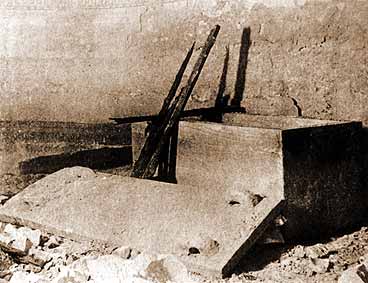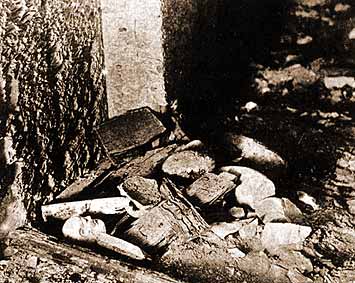In the
later part of 1900, Howard Carter (at this time the Inspector
General of the Monuments for Upper Egypt) sent workmen to the
Valley of the Kings - near to the tomb of Tuthmosis III, after
a short while a doorway to a tomb had been uncovered (originally
two local residents of Luxor applied to Carter for permission
to dig after declaring that they knew where an undiscovered tomb
lay - Carter granted permission but sent the Head guardian of
the tombs to supervise).
The tomb
had been robbed and flooded in antiquity, the burial chamber
itself appeared never to have received its intended burial -
the sarcophagus was unpolished,+ undecorated and seemingly had
not been placed in its proper resting place in the tomb:
The tomb
itself was undecorated apart from a starred ceiling and the 'heker'
painted on the walls (the 'heker' was a representation of knots
with plant stems - they were used not only for decoration but
also had religious significance, they referred back to the primeval
home of the god - the national shrine, and symbolise the 'first
time' when the gods ruled Egypt). The tomb had not received any
other decoration, the text of the Amduat was missing.
The owner
of the tomb was unknown - one possibility was that it was prepared
for Tuthmosis II, a king whose tomb had yet to be found (the
size of the burial chamber in the shape of a cartouche, the walls
ready to receive the texts of the Amduat would suggest that it
was built for a king) - the perhaps sudden death of Tuthmosis
II would explain the unfinished aspects to the tomb.
However,
when the tomb was cleared of the debris that the flood waters
had brought into the tomb, funerary objects from the burials
of three people were found - Sennefer (mayor of Thebes during
the reign of Amenhotep II), the wife of Sennefer - Sentnay, and
a second woman - Beketre (of no relantion to Sennefer). Carter
then believed that the tomb must therefore be a tomb of a commoner
dating to the period of Tuthmosis III to Amenhotep II.
A further
20 years later, Carter found evidence outside the tomb that would
give a third possibility as to the owner of the tomb - foundation
deposits of Merytre Hatshepsut, wife of Tuthmosis III - it could
have been made for a favoured prince or queen dating to the reign
of Tuthmosis III.




